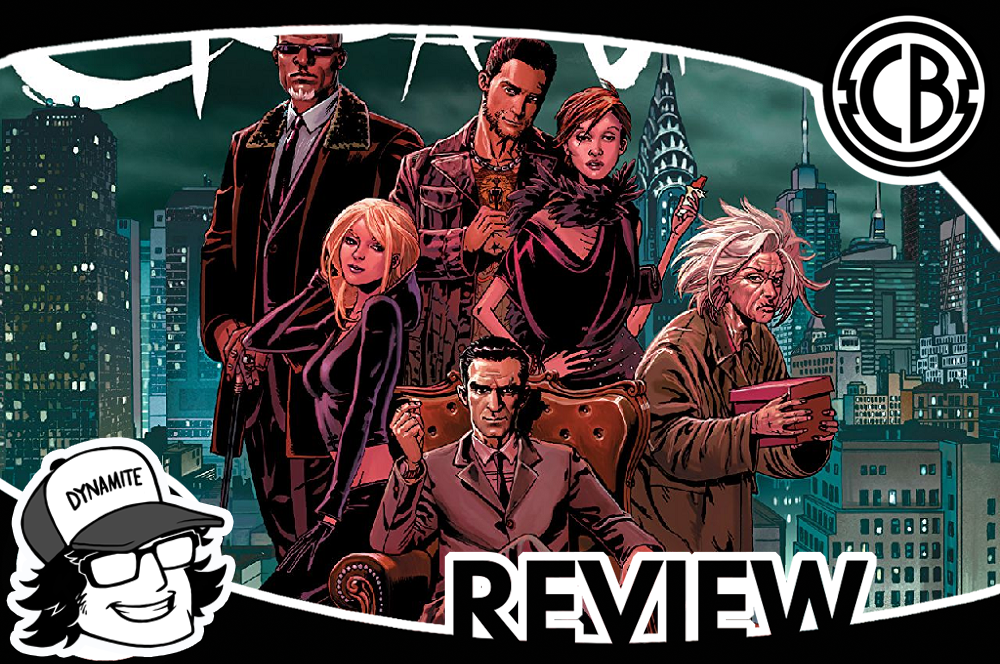Review: Sacred Creatures vol. 1
By Jonathan Edwards
If Ales Kot’s Wolf taught me anything (other than that a mediocre series can still get you back into reading comics), it’s that I’m a sucker for extra-sized first issues. So, when Sacred Creatures #1 came out in July of 2017 boasting a whopping 66 pages on top of a contemporary fantasy story (a subgenre I already prefer), I was more than a little intrigued. I picked up the first issue, as well as the other issues in the first volume as they came out, but they all ended up unread and in my backlog. That is until I signed up to review this trade.
Now, one of the most immediately noticeable things about Sacred Creatures is that it’s a relatively densely written series. Unlike the aforementioned Wolf, there’s not a lot of decompression here. Seriously, between the immediately large cast of characters, nonlinear storytelling, character actions constantly shifting the status quo, and massive amounts of dialog and narration, it’s no wonder that every issue, not just the first, exceeds 40 pages. What’s more, the majority of them, (that’s four out of six) go on to break 50 pages, and the sixth issue joins the first in coming in over 60. Yeah, that’s over 300 pages total, all packed full of story and information. And, I could understand why that might turn someone off from this series, but, frankly, that’s what makes it such an enjoyable read. At the very least, you know you’re getting something that’s thoroughly thought out and gives you plenty to chew on while promising more to come.
Similarly, the worldbuilding might also initially seem like a turnoff due to the sheer amount of exposition required for it, but here’s the thing: writers Pablo Raimondi and Klaus Janson know how to leverage those scenes so that the information revealed actually drives the story forward instead of merely establishing things that later events wouldn’t make sense without. Furthermore, they provide just a fascinating and well-researched take on the source material. I personally went in knowing what said source material is, and I don’t regret that. However, I do recognize that elaborating on it here could be considered spoilers, as its proper explanation doesn’t begin until near the end of the second issue. So, if you’re interested and don’t want to hear anymore, go ahead and skip to the next paragraph. For everyone else, there are two main influences: the Seven Deadly Sins, including at least one reference to the previously accepted eight sin, vainglory (simply referred to as “vanity” here), as well as the myth of the Watcher angels and their offspring, the Nephilim, from the now extrabiblical Book of Enoch. Sacred Creatures is far from the first series to use both of these sources in tandem, but few I can think of have done so to create as much of a completely cohesive narrative as is present here.
As for the story itself, it follows 24-year-old Josh Miller, a college student and expecting father who’s looking for a means to support his soon-to-be family. Through a variety of different flashbacks, we learn the kind of guy he was, and how his life has gone completely topsy-turvy over the last week or so thanks to the efforts of seven not-so-normal siblings. We meet Josh at the culmination of all this, where he’s covered in someone else’s blood, wielding an ancient stone dagger, and doesn’t exactly remember what just went down. We’re also quickly introduced to many of the book’s other cast members including the seven siblings mentioned above; Father Adrian, a seemingly superhuman priest; Julia, Josh’s pregnant girlfriend; Karen, Julia’s mother; and Detective Leo Crowe with the NYPD.
The writing does occasionally veer in the direction of clichés, but it’s done so with an amount of nuance that ultimately makes those moments pretty genuine and believable. For example: at first, Karen appears to be little more than the stereotypical disapproving mother-in-law type (even though Josh and Julia aren’t married). Yet, when Josh’s well-being is called into question, and the police are looking for him, she shows legitimate concern rather than doubling down on the “I always knew he wasn’t good enough for you” schtick.
In addition to writing, Pablo Raimondi and Klaus Janson both provide the book’s art, with the former handling all “contemporary scenes” and the latter taking on the “ancient past scenes” that start showing up in issue #4. It’s always cool when books distinguish different places and time periods by utilizing different artists, and both of them do a good job here. I think I would have to say that I prefer Raimondi’s work to Janson’s, and even then, there are a few nitpicks I could make about certain expressions, gestures, off-model designs, and ambiguous sequential art. But, none of it truly kills the experience, and there really is just something super cool about them working together as both co-writers and co-artists for this book.
Let me be clear about something: Sacred Creatures Vol. 1 is very much a first volume. And, by that I mean, while a story arc has definitely been completed by the end of it, there are still several unanswered questions. Hell, I’ve pieced together a theory or two from small details that have yet to be elaborated on, and I’m super excited to see how right or wrong they turn out to be. Volume two is supposed to begin sometime in Fall of this year, and I can’t wait. In the meantime, if you want a big, elaborate, wild ride of a comic book to get invested in, I absolutely recommend picking up this volume and giving Sacred Creatures a shot.
Score: 4/5
Sacred Creatures vol. 1
Image Comics


